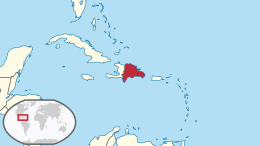Commons:Copyright rules by territory/Dominican Republic
|
Copyright rules: the Dominican Republic Shortcut: COM:Dominican Republic | |
 | |
 | |
| Durations | |
|---|---|
| Standard | Life + 50 years |
| Photograph | Publish or Create + 50 years |
| Anonymous | Create/publish + 50 years |
| Audiovisual | Publish or Create + 70 years |
| Collective | Create/publish + 50 years |
| Other | |
| Freedom of panorama | Yes |
| Terms run to year end | Yes |
| ISO 3166-1 alpha-3 | DOM |
| Treaties | |
| Berne convention | 24 December 1997 |
| Univ. Copyright Convention | 8 May 1983 |
| WTO member | 9 March 1995 |
| URAA restoration date* | 1 January 1996 |
| WIPO treaty | 10 January 2006 |
| *A work is usually protected in the US if it is a type of work copyrightable in the US, published after 31 December 1928 and protected in the country of origin on the URAA date. | |
This page provides an overview of copyright rules of the Dominican Republic relevant to uploading works into Wikimedia Commons. Note that any work originating in the Dominican Republic must be in the public domain, or available under a free license, in both the Dominican Republic and the United States before it can be uploaded to Wikimedia Commons. If there is any doubt about the copyright status of a work from the Dominican Republic, refer to the relevant laws for clarification.
Background
The island of Hispaniola was colonized by the Spanish in the late 15th century. The eastern part became independent in 1821. In the years that followed periods of independence alternated with control by Haiti, Spain and the United States. The last US occupation ended in 1966.
The Dominican Republic has been a member of the Universal Copyright Convention since 8 May 1983, the World Trade Organization since 9 March 1995, the Berne Convention since 24 December 1997 and the WIPO Copyright Treaty since 10 January 2006.[1]
As of 2018 the World Intellectual Property Organization (WIPO), an agency of the United Nations, listed [Law No. 65-00 on August 21, 2000, on Copyright as the main copyright law enacted by the legislature of the Dominican Republic.[1] WIPO holds the text of this law in their WIPO Lex database.[2] The law was modified by Law No. 2-07 of January 8, 2007, but not in a way that affects definitions of works or duration of copyright.[3]
General rules
Under Law No. 65-00 of 21 August 2000,
- Copyright shall accrue to the author during his lifetime and to his spouse, heirs and successors in title for 50 years after his death.[65-00/2000 Article 21]
- In the case of duly established joint authorship, the period of 50 years shall commence on the death of the last joint author.[65-00/2000 Article 21]
- Anonymous works shall be protected for a period of 50 years from the first publication thereof or, failing that, from the making thereof.[65-00/2000 Article 24]*Collective works and computer programs shall be protected for 50 years from publication or, failing that, from the making thereof.[65-00/2000 Article 25]
- For photographs, the duration of copyright shall be 50 years from first publication or public display or, failing that, from the making thereof.[65-00/2000 Article 26]
- Audiovisual works shall be protected for 70 years from first publication or presentation or, failing that, from the making thereof, without prejudice to the rights in original works incorporated in productions.[65-00/2000 Article 27]
The periods established in the present Chapter shall be calculated from January 1 of the year following that of the death of the author or, where appropriate, that of the disclosure, publication or making of the work.[65-00/2000 Article 28]
Currency
See also: Commons:Currency
![]() Not OK There is no exception for currency under Dominican copyright law. Under Law No. 65-00 of 21 August 2000,
Not OK There is no exception for currency under Dominican copyright law. Under Law No. 65-00 of 21 August 2000,
- Rights in works created by public employees or officials in the performance of the duties inherent in their position shall be presumed to be assigned to the public organization in question.[65-00/2000 Article 28]
Freedom of panorama
See also: Commons:Freedom of panorama
The reproduction, distribution and communication to the public of news of the day and other information relating to facts or events in the news that have been publicly disseminated by the press or by means of broadcasting shall be lawful. It shall also be lawful to reproduce and make accessible to the public, in connection with the reporting of current events by means of photography, broadcasting or communication to the public by cable or other analogous means, works seen or heard in the course of such events, to the extent justified by the informatory purpose.[65-00/2000 Article 34]
Works permanently located on public thoroughfares, streets or squares may be reproduced by means of painting, drawing, photography or audiovisual fixations, and such reproductions may be distributed and communicated publicly. With regard to works of architecture, this provision shall apply only to their external aspect.[65-00/2000 Article 39]
Citations
- ↑ Jump up to: a b Dominican Republic Copyright and Related Rights (Neighboring Rights). WIPO: World Intellectual Property Organization (2018). Retrieved on 2018-11-08.
- ↑ Law No. 65-00 on August 21, 2000, on Copyright. Dominican Republic (2000). Retrieved on 2018-12-11.
- ↑ Law No. 2-07 of January 8, 2007, on Amendments to Article 189 of Law No. 65-00 on Copyright. Dominican Republic (2007). Retrieved on 2018-11-08.